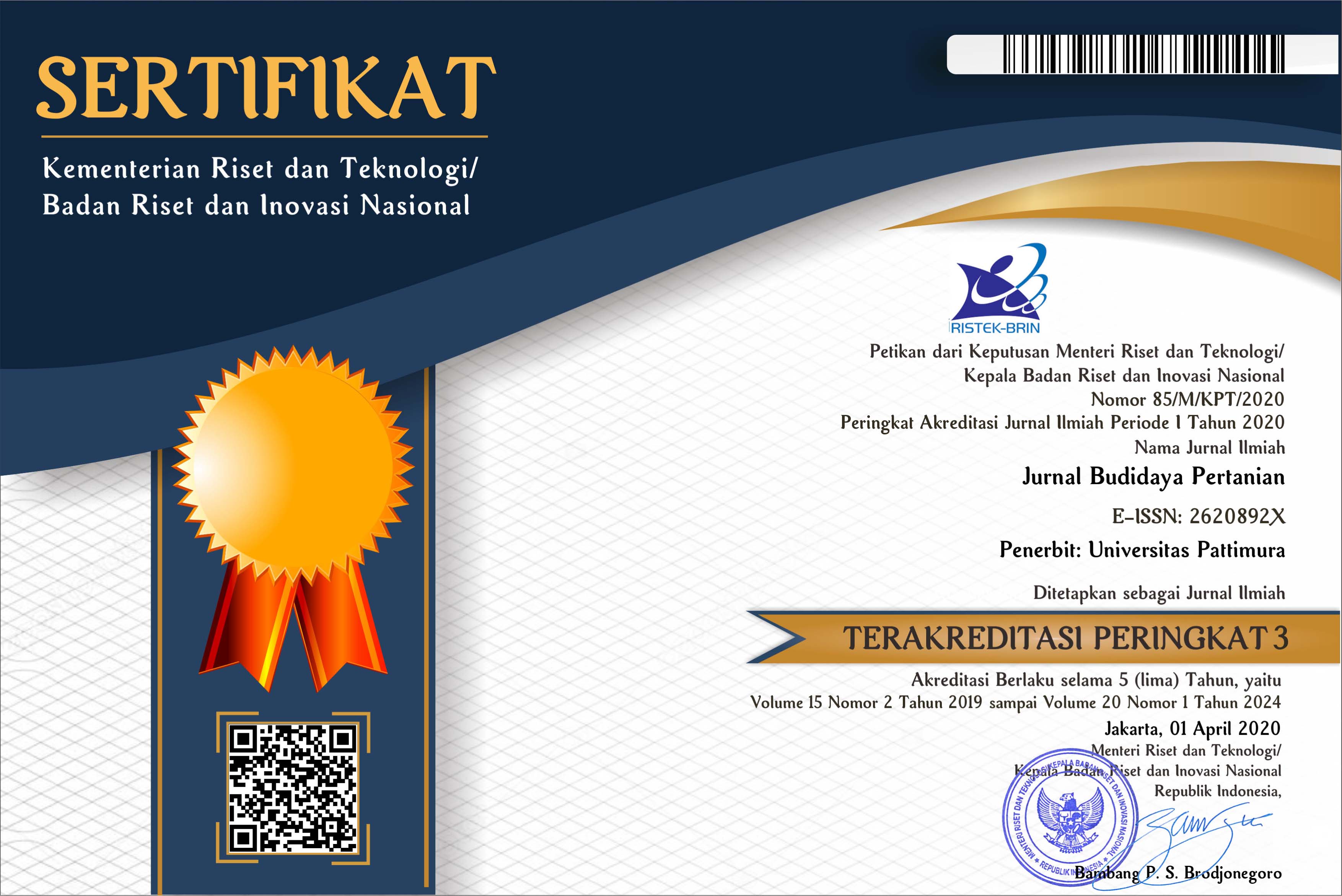Species Diversity and Nesting Descriptions of Stingless Bees (Apidae; Meliponini) on Ambon Island
Abstract
Stingless bees have an important role, namely as a potential pollinator for increasing the production of various plants, as well as producing honey and propolis. This study aims to obtain species diversity, morphological characters, morphometric characteristics of stingless bees and descriptions of types of nesting stingers. It was carried out from March to May 2021. Observations of the morphological characters of the worker strata included: body color, thorax, mesoscutum, mesoscutellum, propodeum, abdomen, forewing color, number of hammuli, posterior hair of the back tibia, and elliptical disc on the inside of the back basitarsus. While the morphometric strata of workers measured were: body length, head width, head length, eye width, malar space length, second flagellomere width, long wingspan and tegula, back tibia width, back basitarsus width. Observations of stingless beehives include: hive height, nest location/material, entry length and diameter, entrance color and texture. The results of the study of the stingless bee species found in Leihitu District were T. clypearis, and in Salahutu District were T. clypearis and T. fuscobalteata. The morphological character of the species of T. clypearis is the body has a brownish black color with a size of 3.36-3.56 mm, the belly color is blackish brown. Species T. fuscobalteata dominant body brownish black with a body size of 2.78-3.24 mm brownish yellow belly color. Description of the nest of T. clypearis species, namely: nest height 26-219 cm, entrance brown and black, hard and soft structure, entrance hole length 0.3-7 cm, diameter 0.3-4 cm. Types of nesting T. fuscobalteata were: nesting height 160-193 cm, entrance brown, hard and soft structure, entrance length 0.8-1.3 cm, diameter 0.3-1.2 cm. With nesting substrates namely wood, stone and iron.
Downloads
References
Anaktototy, Y., Priawandiputra, W., Sayuti .T., Lamerkabel, J.S.A., Raffiudin,R. (2021). Morfologi dan variasi morfometrik stingless bees di Kepulauan Maluku, Indonesia. Jurnal Entomologi Indonesia 18(1),10-10. https://doi.org/10.5994/jei.18.1.10.
Bookhout, T. A. (1996). Research and management techniques for wildlife and habitats. Kansas (US), Allen Press Inc. ISBN-10: 093586881X .
Dollin, AE., Dollin LJ., Sakagami SF. (1997). Australian stingless bees of the genus Trigona (Hymenoptera: Apidae). Invertebrate Taxonomy. 11, 861–896. https://doi.org/10.1071/IT96020.
Hadisoesilo, S. (2001). Keanekaragaman Spesies Lebah Madu Asli Indonesia. Biodiversitas. 2(1),123-128. https://doi.org/10.13057/biodiv/d020107
Indrayanti, Ni Wayan. (2021). Studi Pakan Polen Lebah Tetragonula Biroi di Desa Pepuro Barat Kec.Wotu Kab. Luwu Timur. Universitas Hasanuddin. Makassar. http://repository.unhas.ac.id/id/eprint/2976/2/M11115050_skripsi%20I-II.pdf
Lamerkabel, J.S.A. (2011). Mengenal Jenis-Jenis Lebah Madu, Produk-Produk dan Cara Budidayanya. Jurnal Ilmu Pengetahuan dan Teknologi (Logika). Volume 9, Nomor 1. Mei 2011. ISSN : 1693-9018. Alumni Pasca Sarjana Universitas Negeri Jakarta. Ambon. https://ejournal.unpatti.ac.id/ppr_paperinfo_lnk.php?id=841
Lamerkabel, J.S.A., Jesayas,H., Leatemia, J. A. (2018). Distribution and Nesting Site Stingless bee Tetragonula fuscobalteata Cameron in Ambon Island Moluccas.http://repository.uinjkt.ac.id/dspace/bitstream/123456789/50763/1/The%20Effects%20of%20Temperature%2C%20Pests%2C%20Nectar-Producting%20Plants%20and%20Log.pdf
Lamerkabel,,J.S.A., Jesafat, H., Ririhena, R.E. (2017). Tabiat bersarang Lebah Madu Tak Bersengat Tetragonulabiroi (F.) dan Tetragonulafuscobalteata (C.) Asal Pulau Ambon, Maluku. Artikel Ilmiah. Presentasi Oral pada Seminar Nasional Perlebahan Indonesia. Kampus IPB Dramaga, Bogor.
Lamerkabel, J.S.A., Victor, G Siahaya., Wulandari, Saepuloh., Anang, Lastriyanto., Mochammad, Junus., Erwan., Jati Batoro., Firman Jaya., Dewi Masyithoh. (2021). Karakteristik Morfologi dan Morfometrik Lebah Madu Tak Bersengat (Apidae;Melliponinae) pada Kolni di Daerah Pesisir Pulau Ambon. Vol. 17(1): 28-35 Th. 2021. https://doi.org/10.30598/jbdp.2021.17.1.28
Michener, CD. (2000). The bees of the world. Johns Hoppkins Univ. Press; Baltimore, United States. Xvi + 953 pp.
Pavithra, PN., Shankar, MR., Prakash, J. 2013. Nesting Pattern Preferences of Stingless Bee, Trigona iridipennis Smith (Hymenoptera: Apidae) in Jnanabharathi Campus, Karnataka, India, Int.Res.J.Biological Sci., 2(2), 44-50.
Rasmussen, C. (2017). Stingless bee (Hymenoptera: Apidae: Meliponini) of the Indian subcontinent: diversity, taxonomy and current status of knowledge. Zootaxa3647(3): 401–428. https://doi.org/10.11646/zootaxa.3647.3.1.
Roubik, D.W. Stingless bee nesting biology. Apidologie 2006, 37: 124-143. https://doi.org/10.1051/apido:2006026
Sakagami, S.F. (1978). Tetragonula stingless bee of the continental Asia and Sri Lanka(Hymenoptera, Apidae).
Journal of the Faculty of Science, Hokkaido University, Series VI, Zoology 21: 165–247.
https://eprints.lib.hokudai.ac.jp/dspace/bitstream/2115/ 27635/1/21%282%29_P165-247.pdf
Sakagami,SF., Inoue, T. (1987). Stingless bee of the genus Trigona (subgenus Trigonella) with notes on the reduction of spatha in male genitalia of the subgenus Tetragonula (Hymenoptera;Apidae). Kontyu. 55(4): 610-627.
Smith, D. (2012). Indo-Malayan Stingless Bees: Key of Workers. 11th AAA Conference Stingless Bee Workshop.
Suranto, A. (2007). Terapi Madu. Penebar Plus. Hal : 27-28, 30-32. Jakarta.
Suriawanto, N. (2016). Keanekaragaman dan Tempat Bersarang Lebah Tak Bersengat (Hymenoptera: Apidae) di Sulawesi Tengah. Thesis. Institut Pertanian Bogor. https://repository.ipb.ac.id/handle/123456789/81571
Wille, A. Michener CD. 1973. The nest architecture of the stingless bee with special referance to those of Costa Rica. Rev. Biol. Trop. 21(1): 1-278. ISSN: 2278-4705.
Copyright (c) 2023 Jacobus S A Lamerkabel, Ria Y Rumthe, Marsia E Sarkol

This work is licensed under a Creative Commons Attribution-ShareAlike 4.0 International License.

 Accreditation is valid for 5 years, starting from Volume 15 Issues 2 December 2019 up to Volume 20 Issue 1 June 2024.
Accreditation is valid for 5 years, starting from Volume 15 Issues 2 December 2019 up to Volume 20 Issue 1 June 2024.






